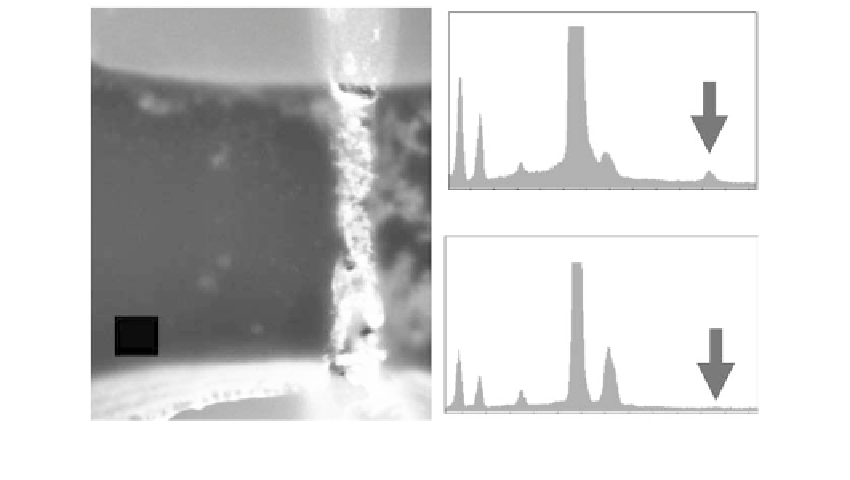Biomedical Engineering Reference
In-Depth Information
surface perturbations. The following examples demonstrate some of the procedures that
have been used to functionalize CP NWs. Most functionalization processes involving CP
nanowires could be termed as noncovalent as the molecule of interest is usually immobi-
lized within the CP matrix during the polymerization procedure. For example, we immo-
bilized biological molecules within CP NWs by entrapping avidin during the
polymerization process [59]. In this process, avidin, streptavidin decorated Cd-Se quan-
tum dots (Aqd) and biotin decorated quantum dots functionalized PPY nanowires were
synthesized/fabricated within 100- and 200-nm wide by 3-µm long channels between
gold electrodes on a silicon substrate fabricated as previously mentioned. As observed
earlier for unfunctionalized CP NWs without biomolecules, well-confined, dendritefree,
and high aspect ratio nanowires were realized by our methodology (Figure 4.10A
)
.
Energy-dispersive X-ray (EDX) analysis confirmed the presence of biomolecule through
the presence of quantum dot Cd
(
Figure 4.10B and Figure 4.10C
)
, while AFM phase imag-
ing analysis verified that biomolecules were uniformly and well distributed and present
on the surface of the polymer
(
Figure 4.11
)
. The latter is necessary for a rapid response
and the detection of large analytes and particles like viruses. The study was performed
on a film equivalent to the thickness/depth of the channel used for nanowire fabrication.
Moreover, the procedure is safe and fast, and environmentally benign reagents are used
in the process.
Mallouk and coworkers [60] have demonstrated the synthesis of segmented biologically
functionalized CP NWs using template method. Au/(PPY)/Au segmented nanowires
loaded with avidin and streptavidin in the polymer component was synthesized as the first
step toward the development of nanoscale biosensors and assemblies. Avidin and strepta-
vidin were introduced into the nanowires by entrapment during PPY polymerization.
The high specificity of the association between these proteins and biotin was used to mon-
itor protein incorporation and accessibility in the CP segments of the nanowires as a func-
tion of the conditions of synthesis.
Silicon
(B)
(A)
Cd
peak
Carbon
Oxygen
Gold
Sodium
Cadmium
Chlorine
0.4
1.0
1.6
2.2
2.8
3.4
4.1
Energy values
Silicon
(C)
No Cd
peak
200 nm
Gold
Carbon
Oxygen
Sodium
Chlorine
0.3
0.9
1.5
2.1
2.7
3.3
3.9
Energy values
FIGURE 4.10
(A) SEM image of an Aqd-embedded PPY nanowire (200 nm wide). The energy-dispersive X-ray (EDX) analysis
of PPY nanowire with embedded Aqd (B) and without embedded Aqd (C) [59]. (From Ramanathan, K., Bangar,
M., Yun, M., Chen, W., Myung, N., Mulchandani, A. (2005). Bioaffinity sensing using biologically functionalized
conducting-polymer nanowire.
J
.
Am
.
Chem
.
Soc
., 127:496-497. With permission.)



